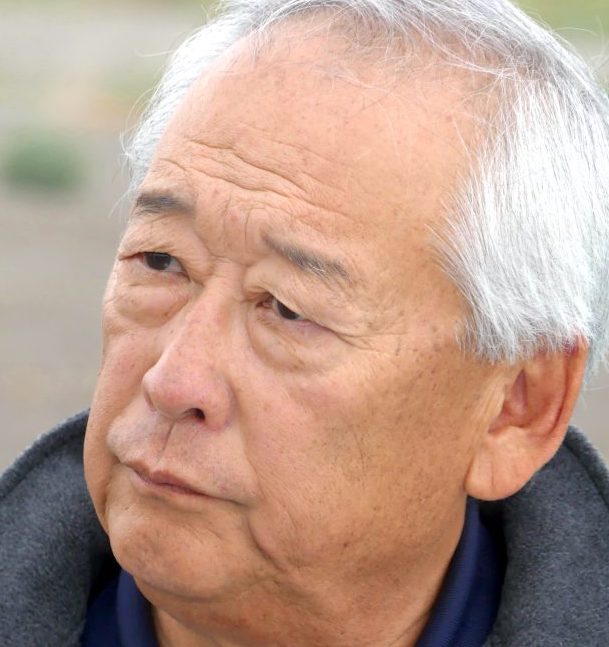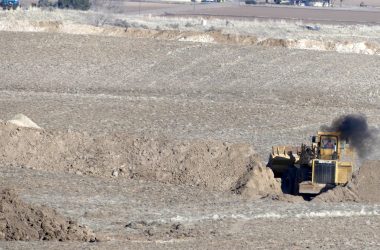UPDATE: 4 p.m. Tuesday, Feb. 20: The Malheur County Development Corp.’s new business plan was released. A link to the plan has been added.
ONTARIO – Developers of the Treasure Valley Reload Center recently unveiled a new business plan to get the beleaguered project into operation without more public money and save local onion producers $4 million through one of the region’s largest publicly-funded ventures in recent times.
Under the draft plan, Malheur County Development Corp. would run the Nyssa terminal itself, a significant about-face from plans in place for years. The public company estimates that it can cover all its costs through fees, ending taxpayer support that has propped up the project for seven years.
The proposal also envisions finishing a slimmed-down version of the terminal, using borrowed money instead of more public funding to bring home the $40 million project.
The new plan, unveiled Wednesday, Feb. 7, projects a substantial reduction in the volume of onions that will move through the facility.
Under the new blueprint, the equivalent of 600 rail cars of onions will move out of Nyssa. That represents about one third the volume that project developers said would roll as they persuaded state and county officials to put millions of public dollars into the project. The volume now is expected to total 2.040 million bags of onions, compared to 5.9 million listed in the beginning.
READ: Treasure Valley Reload Center business plan
The ambitious plan leaves unresolved pivotal issues that could affect whether the new plan is realistic. Those include shipping prices, terminal operations, a new partner in the Midwest and cost cuts to the main terminal building.
Project leaders are on the hunt for a new operator even though they lack a commitment from onion shippers and producers.
Project leaders say they would likely resume construction of the Nyssa depot without having any customer contracts in place. They said they instead would rely on the good faith of onion producers to use the facility as they have said in recent conversations.
The company said it would be difficult to operate otherwise until it establishes a record of “successful operations.”
“MCDC is banking on one of the most powerful motivators in the world – FOMO (fear of missing out) to drive demand for the new TVRC facility,” the company said in response to draft excerpts of this story provided by the Enterprise.
The development company no longer envisions using rail the entire way to East Coast markets – once considered a central advantage for the Nyssa operation. Now, onions would be taken only part way across country by rail, transferring back to trucks for the remaining journey to the East Coast.
Onions will be shipped from the Nyssa facility to the end of the Union Pacific Railroad line at a destination such as Chicago and St. Louis or other cities.
That piece of the logistics puzzle, though, remains murky. That’s because MCDC has not yet identified an operator to handle that crucial piece of the project.
Such an operator would be responsible for an estimated 2,400 truck shipments a year.
Shawna Peterson, the development company executive director, said that new operator also would be tasked with negotiating with Union Pacific.
That role previously was reserved for Americold, the firm initially contracted to operate the Nyssa facility.
Americold’s corporate muscle was deemed essential for the reload center and future plans hinged on the company as the operator of the facility.
In a 2020 fact sheet, state officials concluded that the development company “does not have the expertise to actually run and manage this type of facility. It is critical that the facility is run by an entity who understands shipping dynamics, logistics and working with railroads.”
Americold bailed out of the operator agreement last summer because of what it deemed “the lack of commitment and resources behind this project.” The company also said it did not believe the center was “financially viable.”
Once Americold departed, some directors on MCDC board criticized the firm’s plan and its requirements. Three directors have served since the board was founded in 2017 – Grant Kitamura, an executive with Baker and Murakami Produce Co. in Ontario, Kay Riley, retired executive from Snake River Produce in Nyssa, and Corey Maag, an owner of Jamieson Produce of Vale.
The new business plan identified flaws in the Americold plan that had not been publicly voiced before by onion industry executives. One weakness, according to the new business plan, was “Union Pacific rail cars originating in Nyssa must be interchanged in either the CSX or Norfolk Southern Lines. This greatly increases transit time to the eastern seaboard.”
Other flaws included “many receiving locations, creating a complex and unwieldly operator network.” Americold had said it would move onions to four cities. The MCDC plan also said that another flaw in the original plan was the high cost of linking to East Coast railroads.
The industry now is publicly saying for the first time that Americold’s proposed charges weren’t feasible.
“It was a situation that, you know, frankly we worked for them a long time before they revealed what they wanted to charge us. They wanted to charge us all the savings in shipping,” Kitamura said during a recent interview.
State officials advised the Oregon Transportation Commission in 2020 briefing paper that the Americold contract was crucial because “bringing on Americold has opened up new market destinations for produce from the TV (Treasure Valley) area.”
Americold presented detailed pricing charges to shippers in a document dated Nov. 23, 2020.
A year later, at the groundbreaking for the Nyssa project, an Americold executive shared the spotlight.
“We were very fortunate to hook up with Americold,” Kitamura said at the event.
Now, it appears project leaders are on the hunt for a new operator even though they lack a commitment from onion shippers and producers. That circumstance earlier helped doom Americold’s participation.
As recently as last September, the state Transportation Department emphasized that getting a qualified operator for the Treasure Valley Reload Center was crucial for the state to release more money for construction.
The draft business plan shows that MCDC would pay for Nyssa operations fully from the fees. The company also would use those fees to cover costs now covered by Malheur County, including the $120,000 a year for an executive director.
The original plan from 2018 included projections of rail shipments that were calculated by ECONorthwest of Portland. The consulting firm’s work was key to the 2018 plan, providing to the state justification for the rail center. The study reviewed shipping, market demand, profits and operating costs among factors showing a rail center was needed.
Yet the firm’s work, which cost $131,000, has since been dismissed by some members of the development corporation. In November, Kitamuraand Riley questioned data in the report.

Last week Kitamura said he believes EcoNorthwest was “confused” and MCDC had very little to do with its report.
“They didn’t hardly talk to anybody. We met with them a couple of times. It was strange that they came up with these conclusions,” said Kitamura.
He wrote the cover letter that provided those conclusions to state officials, telling them the document “delivers on the expectations of the State of Oregon and the public.”
Another potential issue for developers of the rail center is the predictability of Union Pacific service and rail car availability. Kitamura said if a shortage of rail cars does occur, the development corporation could lease cars.
The truck transportation issue is important because the 2018 project proposal lauded the public benefit of removing roughly 4,000 trucks from the road. Fewer trucks would slash emissions, cut down on the maintenance needed for highways and potentially save lives because of fewer crashes. The current business plan makes no mention of public benefits.
The current plan also does not address unpacking the onions and trucking them to locations back east. In total, estimates indicate the new plan would keep more than 7,000 trucks on the road, instead of removing 4,000 trucks.
Peterson said under any plan, trucking onions is necessary to get them to their destination. She said conversations about truck availability from the Midwest destination have not gone beyond the development company board.
Treasure Valley onion shippers have said one reason they support the Nyssa center is the trouble they have had getting trucks to move their 50-pound bags of onions. Peterson suggested that isn’t an issue in other parts of the U.S.
“I think the trucking is a geographical thing in part on the other end,” she said. “I’m not sure that trucking is such a traumatic thing. We’ve had conversations about that.”
The big winners in the new plan will be onion producers and shippers based on projections they can save an average of $2.08 per 50-pound bag of onions shipped.
With the volume projected in the business plan, the Nyssa terminal could save the industry $4.2 million a year in shipping costs.
MCDC in its statement last week disclosed for the first time that not all the savings may be given to the industry. The company might keep some of the money for “additions to cash on hand or loan principal reduction.”
Peterson, however, agreed savings would improve the profitability of the onion producers and not necessarily lead to more employment.
Kitamura said such savings could allow the industry to afford to hire more employees. That, in turn, he said, will boost the local economy.
According to the report, 55% of the onions estimated to be funneled through the facility will come from Idaho. Those producers will see the same cost savings as their Oregon counterparts even though Idaho is not funding any of the construction costs of the Oregon depot.
Peterson said that is just the nature of where the produce is grown in the Treasure Valley. Peterson said the Oregon Legislature could look at preferential pricing or incentives for Oregon producers.
The development corporation still needs $6.1 million – on top of the $38 million in public money already spent or committed – to finish the project. Plans now call for the corporation to borrow the money, repaying such a loan from fees collected from terminal users.
The development company is considering changes to the terminal building, including dropping refrigeration and a fire sprinkler system.
“There has been too much delay already and MCDC is acting with a sense of urgency.”
–Malheur County Development Corp.
The new plan was produced by Peterson and Mike Walker, an Adrian farmer who has been a critic of project elements. He recently was appointed to the board and set to work assessing how to revive the moribund project.
Walker cooperated with Peterson to develop the new plan after interviewing local onion shippers.
He said he was never against the project.
“I just had a lot of questions because of the way it was managed. The constant delays then, after it got started, the (cost) overruns,” he said last week.
The draft business plan rolls into one piece the separate studies that a consultant had advised in January. Peterson said there would be no formal market study or design review, for instance. She said the plan to “engage” experts to review the fate to the terminal meant talks with experts, not that they would be hired.
Six months ago, Peterson had said all options for the future of the reload center would be considered, from selling off the project to changing its purpose. Last fall, she said there would be promise in using Nyssa as a destination for freight into the Treasure Valley.
Last week, MCDC said such options would be considered in the future.
The company said in its statement to the Enterprise that there is “great promise” for other business lines, including alfalfa. For now, the onion shipping facility will serve as an “anchor tenant.”
“There has been too much delay already and MCDC is acting with a sense of urgency,” the company said.
For now, she is focused on a crucial meeting with Transportation Department officials, scheduled for Wednesday, Feb. 21, to win the state’s support to move ahead.
In August 2023, the Transportation Department stopped the flow of public money – about $8 million – and told project leaders they needed to find an operator for the facility and figure out how to finish paying for construction.
“We will need to see a clear ability to finish constructing the project and a proven facility operator locked in through an operator agreement to consider this a viable project,” the state letter said. “We need a clear determination that this project is still viable.”
The Transportation Department has proven in the past to be lenient regarding progress on the facility. Peterson said last week that state officials were aware the facility did not have an operator but that would not kill state backing.
PREVIOUS COVERAGE:
Consultant: Unclear business plan, incomplete design impede Nyssa rail center
State halts funding for Treasure Valley Reload Center, imposes conditions
State will not enforce deadlines on rail reload project, waiting for new plan
News tip? Send your information to [email protected].
HOW TO SUBSCRIBE – The Malheur Enterprise delivers quality local journalism – fair and accurate. You can read it any hour, any day with a digital subscription. Read it on your phone, your Tablet, your home computer. Click subscribe – $7.50 a month.




